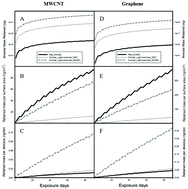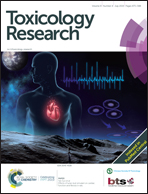Derivation of occupational exposure limits for multi-walled carbon nanotubes and graphene using subchronic inhalation toxicity data and a multi-path particle dosimetry model
Abstract
In this study, we aimed to provide the recommended occupational exposure limits (OELs) for multi-walled carbon nanotubes (MWCNTs) and graphene nanomaterials based on data from a subchronic inhalation toxicity study using a lung dosimetry model. We used a no observed adverse effect level (NOAEL) of 0.98 mg m−3 and 3.02 mg m−3 in rats for MWCNTs and graphene, respectively. The NOAELs were obtained from a 13-week inhalation study in rats. The deposition fractions of MWCNTs and graphene in the respiratory tract of rats and humans were calculated by using the multi-path particle dosimetry model (MPPD model, v3.04). The deposition fraction in the alveolar region was 0.0527 and 0.0984 for MWCNTs and 0.0569 and 0.1043 for graphene in rats and human lungs, respectively. Then, the human equivalent exposure concentrations (HECs) of MWCNTs and graphene were calculated according to the method by the National Institute for Occupational Safety and Health (NIOSH). The HEC was estimated to be 0.17 mg m−3 for MWCNTs and to be 0.54 mg m−3 for graphene, which was relevant to the rat NOAEL of 0.98 mg m−3 and 3.02 mg m−3 for MWCNTs and graphene, respectively. Finally, we estimated the recommended OELs by applying uncertainty factors (UFs) to the HEC as follows: an UF of 3 for species differences (rats to humans), 2 for an experimental duration (subchronic to chronic), and 5 for inter-individual variations among workers. Thus, the OEL was estimated to be 6 μg m−3 for MWCNTs and 18 μg m−3 for graphene. These values could be useful in preventing the adverse health effects of nanoparticles in workers.



 Please wait while we load your content...
Please wait while we load your content...